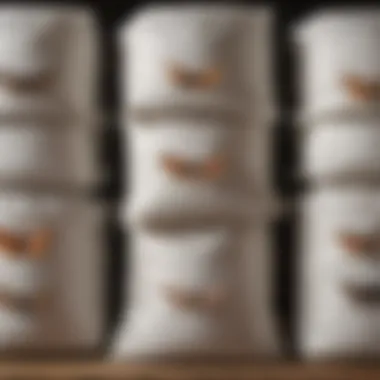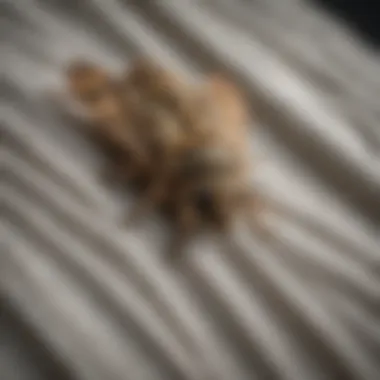Understanding Moth Protection Storage Bags


Intro
Moths can be more than just a nuisance; they can cause significant damage to clothing and stored items. Understanding how to protect valuable belongings is key to effective pest management. This guide will explore the use of moth protection storage bags, detailing their design and benefits. Additionally, we will look into pests themselves, examine prevention strategies, and discuss control methods.
Understanding the Pest
Identification
Moths belong to the Lepidoptera order, which includes butterflies too. Many individuals may not recognize that the common clothes moth is Tineola bisselliella. It is small and typically around 1/2 inch long. This species is the primary destroyer of fabrics in homes. Identifying a moth infestation early can help limit damage.
Life Cycle
The life cycle of a moth is divided into four stages: egg, larva, pupa, and adult. Initially, the female moth lays eggs on or near potential food sources. The larvae that hatch are the ones causing damage, as they feed on fibers, particularly natural ones like wool or silk. Understanding this cycle can aid in prevention and control.
"Moths can lay hundreds of eggs, making them prolific pests in the wrong conditions."
Pest Prevention Strategies
Environment Modification
Creating an environment that is less conducive to moths can be effective. Keep storage areas clean and organized. Vacuuming regularly reduces the presence of adult moths and larvae. It is also helpful to store items in a cool, dry place, as moths thrive in warm, humid environments.
Physical Barriers
Moth protection storage bags act as a physical barrier. These bags are specially designed to keep moths away from stored items. Using them regularly can provide peace of mind, knowing that belongings are safeguarded. Look for bags made from breathable materials that also have security features to prevent moth entry.
Control Methods
Chemical Control
Using chemicals can be an approach for those who prefer fast action. Products like mothballs release toxic vapors that repel moths. However, they should be used with caution as they pose potential health risks. Always read labeling and follow safety guidelines closely.
Biological Control
Another method involves introducing natural predators to the pest environment. Certain parasitic wasps can target moth eggs and larvae. While this may not be a common option for home use, in large settings, biological control can be worth considering.
Prolusion to Moth Protection Storage Bags
Moth protection storage bags serve a vital role in safeguarding valuable textiles and fabrics from potential damage caused by moth infestations. As these pests are notorious for their ability to ruin clothing, upholstery, and other fabric-based belongings, understanding how to utilize storage solutions effectively can save both money and emotional strain. This section details the significance of moth protection storage bags, along with important considerations for their use.
Understanding Moths and Their Impact
Moths tend to feed on natural fibers, which can cause significant damage to various items in homes. These insects are particularly drawn to materials made from wool, silk, and cotton. Infestations can begin unnoticed, leading to costly repairs or replacements. Knowing about common moth species, such as the Indianmeal moth or the webbing clothes moth, is essential in this context. The lifecycle of moths consists of several stages: egg, larva, pupa, and adult. The larval stage is the most destructive one, as this is when they feed on fabrics. By learning to recognize the signs of moth activity, such as holes in clothing or adult moths fluttering around, homeowners can avert significant loss.
The Role of Storage Bags in Pest Control
Storage bags designed specifically for moth protection create an environment that minimizes the risk of infestation. They are typically made from materials that include breathable fabrics or plastic with features that inhibit moth access. These bags work by sealing off items from potential pests while allowing for airflow to prevent moisture buildup, which can attract moths. Additionally, many moth storage bags contain ingredients or treatments that repel these insects, thus enhancing their efficacy.
"Using moth protection storage bags not only preserves your belongings but also promotes a pest-free home environment."
To maximize their effectiveness, it is crucial to understand how to select the appropriate bags based on the items being stored. Factors such as size, durability, and sealing ability play a significant part in their success. Overall, employing moth protection storage bags is an essential strategy for effective pest management, especially for individuals who value their fabric items.
The Composition of Moth Protection Storage Bags


The composition of moth protection storage bags plays a crucial role in their effectiveness. Understanding the materials and design features used in these bags allows homeowners and pest control professionals to make informed choices. Selecting the right storage bags can enhance protection against moth infestations and preserve valuable items.
Materials Used
Moth protection storage bags often utilize a variety of materials to create a barrier against pests. Commonly, these bags are made from thick, durable plastics that not only prevent moths from penetrating but also protect items from moisture and dust.
Some bags feature polyethylene or polypropylene, known for their strength and resistance to tearing. Manufacturers may also incorporate additional treatments, such as anti-static or anti-microbial coatings. These treatments further discourage moth activity and protect fabrics from deterioration.
When choosing a bag, consider the following:
- Thickness: A thicker material often provides better protection.
- Breathability: Some bags are designed with breathable fabrics. This can help prevent mold and mildew while still preventing moth entry.
- Safety: Ensure that materials are safe for long-term storage. Non-toxic options are available and should be considered, especially for storage of clothing and fabrics.
Design Features Enhancing Effectiveness
How a moth protection storage bag is designed can significantly impact its efficiency. Various design features work together to maximize protection against moths.
- Sealing Mechanisms: Many storage bags include zip closure or resealable zippers. These mechanisms provide a strong seal, preventing moths from infiltrating the bag.
- Transparent Material: Some bags are made from transparent materials, allowing users to quickly identify contents without opening the bag. This feature not only adds convenience but also ensures that items do not need to be removed frequently, minimizing exposure to potential infestations.
- Reinforced Edges: Bags with reinforced seams or stitching are less likely to rip or tear, offering enhanced durability during transport and storage.
- Size and Shape Options: Availability of different sizes ensures that homeowners can find bags suitable for various items, from small clothing pieces to larger blankets or seasonal decorations.
In summary, understanding both the materials and design features of moth protection storage bags is essential for effective pest management. These factors contribute to the overall performance of the bags, ensuring that valuable belongings are safeguarded against damaging moth infestations. This knowledge empowers users, making it easier to select bags that meet specific needs, enhancing both usability and protection.
Benefits of Using Moth Protection Storage Bags
The importance of moth protection storage bags cannot be understated. In a world where textile preservation is crucial, these bags serve as an effective solution against the damaging effects of moths and other pests. By using these storage bags, homeowners can ensure that their belongings remain in excellent condition while also preventing potential infestations from spreading. Let’s explore the key benefits in detail.
Preservation of Fabrics and Textiles
One of the primary benefits of moth protection storage bags is the preservation of fabrics and textiles. These bags act as a barrier, shielding valuable items from moth larvae that can cause irreparable damage. Fabrics such as wool, silk, and cashmere are particularly vulnerable to moth infestation.
Before placing items in storage bags, ensure they are clean. Dirt, sweat, and food residues can attract moths, undermining the purpose of the bags. Using moth protection bags can extend the life of your textiles significantly. They can keep your favorite sweaters and delicate linens intact for years.
"Moth protection storage bags provide an essential layer of defense, reducing the need for costly repairs or replacements."
Prevention of Infestation Spread
Moth protection storage bags also play a vital role in preventing the spread of infestations. If one part of your home becomes infested, it can quickly affect others. By securely sealing items within specialized bags, you can contain any potential threats. This containment prevents moths from migrating through closets, attics, or storage areas, creating a safer environment for your other belongings.
It is important to check regularly for signs of moth activity even when using these bags. In addition to containing infestations, proper maintenance of these bags and the items inside them is crucial. Regular inspections can help catch any issues early before they escalate into a more significant problem.
Cost-Effectiveness Compared to Damage Repair
Another significant advantage of using moth protection storage bags is their cost-effectiveness compared to damage repair. Repairing damaged textiles can often be more expensive than prevention methods. Consider the costs of mending moth-eaten clothing or replacing entire wardrobes.
Using these storage solutions is a small investment that pays off by preventing extensive damage. With proper use, these bags not only protect belongings but can also save considerable costs in repairs or replacements. This logic supports why investing in quality moth protection storage bags is a sound financial decision for homeowners.
Choosing the Right Moth Protection Storage Bag
Choosing the right moth protection storage bag is crucial for effective pest management and safeguarding valuable items. Moths are known for damaging fabric, wool, fur, and similar materials. Thus, selecting a bag that properly fits your storage requirements can make a significant difference. Key elements include size, capacity, seal quality, and durability of the bags.
Evaluating Size and Capacity
When evaluating size and capacity, consider the items you plan to store. Moth protection bags come in various dimensions. It is important to ensure the bag fits your items without excessive space. Rooms for unnecessary movement can allow air to enter, posing a risk for potential infestations. Choose bags that provide a snug fit for your textiles.
- Determining Item Size: Measure the dimensions of the items before purchasing. Whether you are storing seasonal clothing or heirloom fabrics, having accurate measurements gives you a better chance of finding the right bag.
- Considering Bulk: Take into account how many items you need to store. If you have a considerable collection, opt for larger bags or multiple smaller ones to avoid overcrowding.
- Reviewing Capacity Labels: Manufacturers typically list the capacity on packaging or product descriptions. Pay attention to this data as it guides your selection process.


Assessing Seal Quality and Durability
The quality of a bag's seal directly influences its effectiveness in preventing moth infestations. An inadequate seal can allow pests to enter, ultimately defeating the purpose of the storage solution. Assessing both seal quality and overall durability is thus essential.
- Types of Seals: Look for storage bags with heavy-duty seals. Zippers are commonly used and can be effective if they are strong. Velcro also provides a secure closure, although it may not be as tight as a zipper. Consider each option based on ease of use and reliability.
- Material Strength: The durability of the material used in making the bag matters greatly. Select bags crafted from tear-resistant materials. This helps avoid potential breaches caused by wear and tear over time.
- User Reviews: Consulting user reviews online can help you gauge whether the seal holds well under regular conditions. Look for feedback regarding how well the bags protect items over long periods.
Choosing the right bag requires thoughtful consideration of size, capacity, seal quality, and durability. Each factor intertwines with pest management strategies. In the end, investing in the right moth protection storage bags will pay off by contributing to the longevity of your belongings and preventing costly damage.
Effective Usage of Moth Protection Storage Bags
Using moth protection storage bags effectively is vital for maintaining the integrity of your fabrics and other belongings. These bags serve as the first line of defense against moth infestations. It is not just about putting your items away; effective usage involves preparing and sealing them properly to ensure maximum protection.
Preparing Items for Storage
Cleaning and Drying
Cleaning and drying items before placing them in storage bags is critical. Moths are attracted to food residues, dirt, and moisture. By thoroughly cleaning your items, you remove any potential food sources that could entice moths. This process not only ensures the cleanliness of your fabrics but also promotes longevity.
Key characteristics of cleaning include the removal of dust, stains, and odors. Drying completely is also essential as moisture can foster mold growth, which can be detrimental to your items. This method reflects a popular choice because it establishes a solid baseline of cleanliness and freshness.
One unique feature of this cleaning process is that it often involves using appropriate detergents or gentle washes that are kind to fabric. This careful approach preserves the quality of your clothing while ensuring it is moth-proof. However, if items are not dried thoroughly, they can create an environment conducive to mold and mildew, proving disadvantageous in the long run.
Inspection for Infestation
Inspection for infestation is another crucial step. Before storing, examining your items for signs of moths or larvae will help prevent infestations from spreading to other belongings. Identifying these issues early can save you from costly damage and extensive cleaning efforts later.
A key characteristic of this inspection is identifying not only moths but also their eggs and larvae, which can be harder to spot. This diligence in checking for infestations is favored because it actively prevents problems before they escalate.
The unique feature of this inspection process lies in its thoroughness. Taking the time to inspect dimly lit areas like under furniture enables you to detect not just the items to store, but also the environment where these items will be later. It highlights the need for vigilance in maintaining a moth-free zone. A disadvantage here could be the time and effort spent on inspections, but it is essential for long-term benefits.
Proper Sealing Techniques
Proper sealing techniques are equally important for effective usage. After preparing your belongings, sealing them correctly in moth protection bags is necessary to maintain an airtight environment that is unfavorable for moths.
Utilizing specific methods such as rolling or folding items to minimize air pockets enhances the seal's efficiency, ensuring that moth pheromones cannot enter easily. This simple technique can dramatically reduce the chances of infestations. Additionally, choosing the right type of seal—like zip seals or adjustable closures—can be the key to ensuring a secure closure.
A well-executed sealing process prevents pests from accessing stored items, which is key for long-term storage. Investing time in learning sealing methods pays off by preserving the quality of stored fabrics. Regularly checking your seals during the storage period ensures ongoing protection.
Maintenance of Moth Protection Storage Bags
Maintaining moth protection storage bags is crucial for ensuring their longevity and effectiveness. Even the best storage bags can become less reliable over time if not properly cared for. By regularly checking and maintaining these bags, homeowners can protect their textiles from potential moth damage more effectively. It helps avoid costly repairs and replacements of infested items, while also extending the life of the bags themselves.
Periodic Checks and Inspections
Performing periodic checks and inspections on moth protection storage bags is essential. This process helps identify any potential wear or damage that could compromise the bags' effectiveness. Check for visible signs of deterioration, such as torn seams or damaged seals. Such issues can render the bags useless against a moth infestation.
Additionally, inspecting the contents of the bags is important. Look for any signs of moths or eggs, even if the bags are sealed. If any moths or related debris are found, immediate action should be taken. Remove the affected items and clean the area thoroughly to avoid further infestation. Regular inspections, ideally once every few months, will help maintain an effective barrier against moths.
Cleaning and Replacing Bags
Cleaning moth protection storage bags should be part of the maintenance routine. While many bags are designed to resist moths, they can collect dust and other particles over time. Depending on the material, cleaning may involve wiping down the outside with a wet cloth or using a gentle cleaning solution. Always check the manufacturer's guidelines before cleaning to avoid damaging the bags.
Eventually, all storage bags may need to be replaced. Over time, even the best materials can lose their protective qualities. Signs that it might be time for replacement include persistent unpleasant odors, visible wear, or continued issues with moths despite proper usage. When selecting new bags, consider their materials and seals to ensure enhanced protection.


Key Takeaway: Regular maintenance of moth protection storage bags is essential in preventing infestations and prolonging the lifespan of the bags.
In summary, keeping up with periodic checks and cleaning routines is vital to a successful pest management strategy at home. It is always better to be proactive rather than reactive when it comes to protecting textiles from moth damage.
Common Misconceptions about Moth Protection Storage Bags
Understanding common misconceptions about moth protection storage bags is crucial for effective pest management. These bags are designed to offer significant protection against moth damage, but some beliefs may lead to ineffective usage or disappointment. Addressing these misconceptions helps homeowners make informed decisions that ensure their belongings remain safe from infestation.
Effectiveness Against All Types of Moths
One common idea is that moth protection storage bags are universally effective against all species of moths. This assumes that one type of storage bag can sufficiently deter every kind of moth. However, this not entirely true. Moths such as the clothes moth, pantry moth, and others have different behaviors and habitats. While these storage bags are designed to discourage infestations from specific types, they may not be a complete solution for all moths. To maximize protection, understanding the specific type of moth affecting your area is important. Additionally, combining the use of storage bags with other preventive measures, like maintaining cleanliness and inspecting items frequently, will enhance overall effectiveness.
Environmental Concerns Related to Plastic Use
Another prevalent misconception involves environmental concerns surrounding the plastic used in moth protection storage bags. Given the growing conversation about plastic waste and its impact, many may hesitate to use these bags. It is important to note that some manufacturers are moving towards more eco-friendly solutions. Options now exist that utilize recycled materials or biodegradable plastics. These developments cater to environmentally conscious consumers while still providing protection against moth damage. Using these specialized bags does not have to contribute to environmental degradation if one chooses products wisely and promotes sustainable disposal practices afterward.
"Selecting eco-friendly moth protection storage bags can significantly reduce your environmental footprint while providing necessary protection for your belongings."
While it is valid to be concerned about plastic, the emphasis should be on making informed choices about the products used. By choosing responsibly manufactured storage options, homeowners can enjoy the dual benefit of effective pest control while being mindful of environmental impact.
Environmental Considerations
Moth protection storage bags serve a critical purpose in the realm of pest management. However, their environmental impact is a subject that cannot be ignored. Understanding and addressing these considerations is essential not only for effective pest control but also for promoting sustainable practices. This section will explore the eco-friendly options that are available and discuss how sustainable practices in pest management can contribute to a healthier environment.
Eco-Friendly Bag Options
The demand for moth protection storage bags has increased, leading manufacturers to innovate with materials that are both effective against pests and environmentally friendly. Some eco-friendly bag options include:
- Biodegradable Materials: Bags made from materials that decompose over time are becoming popular. These options minimize plastic waste and are less harmful to ecosystems.
- Recyclable Content: Bags that are constructed from recyclable materials encourage users to participate in recycling efforts. By choosing these options, consumers can reduce landfill waste.
- Non-Toxic Treatments: Many brands are moving away from harmful chemicals used in treatment processes. Instead, they focus on natural repellents, which ensures both pest protection and minimal environmental impact.
Choosing eco-friendly bags not only protects belongings from moth damage but also aligns with a broader commitment to sustainability. This is particularly important for home owners who want to balance effective pest management with ecological responsibility.
Sustainable Practices in Pest Management
Sustainable practices in pest management focus on long-term strategies that emphasize prevention rather than reaction. Integrating moth protection storage bags into these practices plays a vital role. Key strategies include:
- Regular Monitoring: Keeping an eye on stored items can prevent infestations before they start. Regular check-ups minimize the need for chemical treatments.
- Holistic Approaches: Combining different pest management strategies can reduce reliance on chemical solutions. Techniques like proper cleaning and storage methods are integral to this approach.
- Education and Awareness: Informing homeowners about the importance of eco-friendly pest controls promotes better decision-making regarding product use.
Adopting sustainable practices not only aids in pest control but also helps in conserving resources and reducing environmental footprints. This mindful approach enhances the efficacy of moth protection storage bags while nurturing a healthier planet.
"The best pest control is prevention. By making educated choices, like using environmentally friendly storage options, we can protect our homes and the ecosystem simultaneously."
Embracing these principles will ensure that personality and effectiveness accompanies the choice of moth protection storage solutions.
Closure on Moth Protection Storage Bags
Moth protection storage bags play a crucial role in safeguarding your valuables against the threat of moth infestations. As we have discussed, these specialized bags not only preserve the integrity of fabrics and textiles but also prevent the escalation of infestations. The need for effective pest management cannot be overstated, especially in households that house textiles or stored clothing. By utilizing these bags, homeowners can ensure their prized possessions remain protected.
Recap of Key Benefits
- Preservation of Fabrics: Moth protection storage bags prevent damage from moth larvae which feed on natural fibers. This represents a strong case for their necessity, particularly for wool and silk materials.
- Infestation Prevention: Quality storage options reduce the risk of moths spreading from one item to another. A single item infested can compromise an entire wardrobe if not contained.
- Cost-Effectiveness: Investing in moth protection storage is far cheaper than replacing damaged items. Over time, this proactive approach saves homeowners significant amounts of money.
- Time-Saving: With proper usage, these bags minimize the need for expensive and time-consuming pest control solutions that often result when an infestation is allowed to spread undetected.
Moth protection storage bags are not just about prevention; they represent a comprehensive strategy to manage household pests efficiently.
Final Thoughts on Effective Pest Management
Effective pest management involves mindful choices, and moth protection storage bags form a key component of this strategy. Awareness of their features and benefits provides homeowners with the tools needed to combat the threat of moths. By examining sizing, sealing qualities, and materials, individuals can make informed choices that bolster their efforts in protecting textiles.
In closing, it’s clear that understanding and utilizing moth protection storage bags is a valuable practice for maintaining a healthy, pest-free home. These bags are more than just a barrier; they are a peace of mind investment against the potential havoc that moths can wreak. Therefore, integrating these solutions into your routine storage practices is not only wise but essential for effective pest management.







